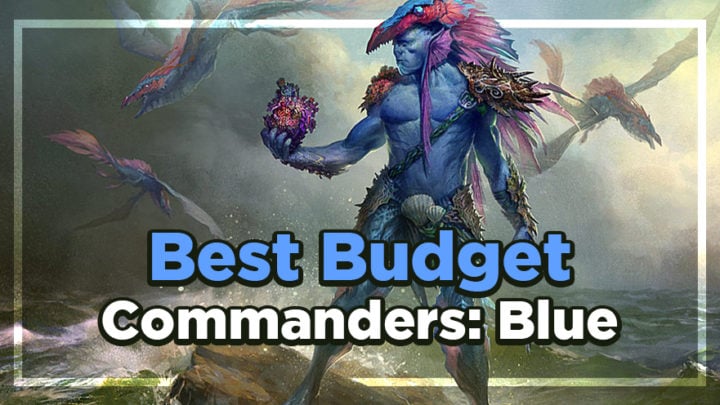Playing Commander at any budget level is not only extremely viable, but incredibly fun. Restrictions breed creativity, and a cost restriction is no exception! Plus, even more affordable, well-built decks can go toe-to-toe with others five to ten times higher in value.
Here’s a list of the best commanders in blue for players on a budget. I’ll be highlighting the archetypes they best support, along with some of the most powerful spells and synergistic combos. Hopefully this will help you find your next favorite deck!
Talrand, Sky Summoner – Spellslinger

Talrand is one of the most popular mono-blue commanders, second only to Urza, Lord High Artificer. They are well-loved for being a powerful and flexible spellslinger commander, and even on a budget, they can maximize some of the best that blue can offer.

Every instant and sorcery will grant you extra value once Talrand is on the battlefield, so it’s wise to cast as many cheap spells as possible. Cantrips like Preordain smooth out your draws and help you dig for answers when you need them. If you have enough of them in your deck, you can even reduce your land count slightly, making it more likely for you to draw into more gas.
Aside from cantrips, you need sources of card advantage. Treasure Cruise and Winged Words are ideal: they are below rate for their effect, and are great for refilling your hand.
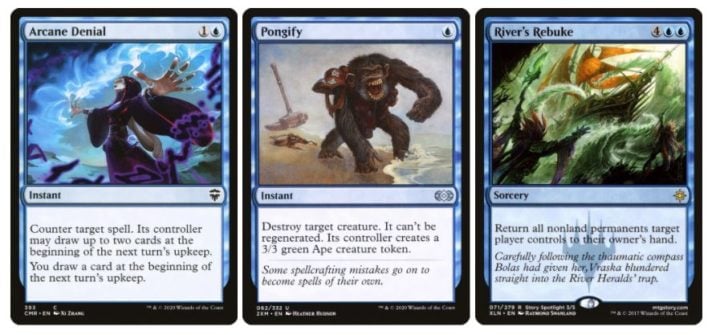
Cheap counters like Arcane Denial or Counterspell are incredible with Talrand; you can use them to protect him, or to stop any spells that may otherwise ruin your game plan. Sometimes, creatures will slip through your counterspells, and hard removal like Pongify is perfect for those moments. When you really need to cut an opponent down to size, River’s Rebuke is a one-sided reset button. Be careful with this last one, however, as it will set the receiving player back to the stone age; it will either knock them out of the running entirely, or you’ll gain a new arch nemesis!

Talrand’s battlefield presence is often enough to keep the board in check, but if you want to double down on payoffs, Murmuring Mystic and Metallurgic Summonings will add their own small armies to the board. Rise From the Tides gives a similar, one-off effect; it’s much better suited to the late game, though, as it requires a high spell count in your graveyard to be worth the mana investment.

If you’re relying on drake tokens to win the game, your deck can benefit immensely from ways to buff the flyers. Favorable Winds is a classic choice, and Heraldic Banner is one I’ve been adding to nearly every mono-color deck I build; a mana rock that reduces your clock by a turn or two is well worth the three-mana investment. Finally, you can lock your opponents out of combat entirely by dropping a Stormtide Leviathan, and dominate the skies with your superior aerial army.
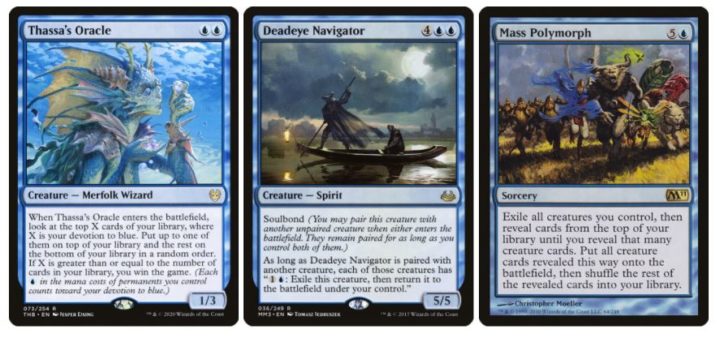
All decks should have more than one way to win the game, and Talrand is no different. Thassa’s Oracle is a reasonable choice if you tend to play longer games, as you can easily draw your deck over the course of a game. The Deadeye Navigator/Peregrine Drake combo is an easy inclusion here, too, provided you have a way to win (Blue Sun’s Zenith or Altar of the Brood).
I own a Talrand deck myself, and my list has a special alternate win condition: Mass Polymorph. My deck only has three creatures in the ninety-nine: Deadeye Navigator, Peregrine Drake, and Archaeomancer. With Talrand and just a couple of drakes on board, you can cast Mass Polymorph, get all three creatures out of your deck, and start comboing off. Once you have unlimited mana, you can flicker Archaeomancer to return every spell from your graveyard. Once you recast Talrand and cast all of your spells, you should have an arbitrarily large army. At this point, you cast Karn’s Temporal Sundering to take an extra turn, and attack for the win. It’s a little convoluted, but it’s technically a reliable one-card combo!
Talrand is arguably my favorite commander of all time, and if you decide to build them, you will soon see why they’re so popular!
Emry, Lurker of the Loch – Artifacts

It is true that strange women lying ponds distributing swords is no basis for a system of government, but this Lurker of the Loch may be the exception that proves the rule. Emry has been around a little more than a year, and she has already become one of the most powerful artifact-based commanders. There are many ways you can build a deck with her at the helm, but perhaps the most potent budget version would be a toolbox build.

A toolbox strategy has answers for just about every situation, but you also need ways to find them. Thankfully, blue has an abundance of artifact tutors at relatively low prices. The artifact mage pseudo-cycle (Trinket Mage, Trophy Mage, etc.) are all exceptional choices; their tutor abilities may be narrow, but if you account for them in the deck-building stage, you’ll always have something worth fetching for.
Whir of Invention and Reshape are also great choices that put artifacts directly onto the battlefield. They generally require artifacts on board to be used, but you certainly won’t find that difficult here.

You won’t be short of powerful and efficient tutor targets, either. You have everything from removal to ramp, and even hate pieces aplenty. Meteor Golem is a great catch-all answer to anything your opponents may have; you can flash in Phyrexian Metamorph using Whir of Invention to cause a number of bizarre situations; Soul-Guide Lantern serves as both targeted graveyard hate and a recurrable form of card draw with Emry.
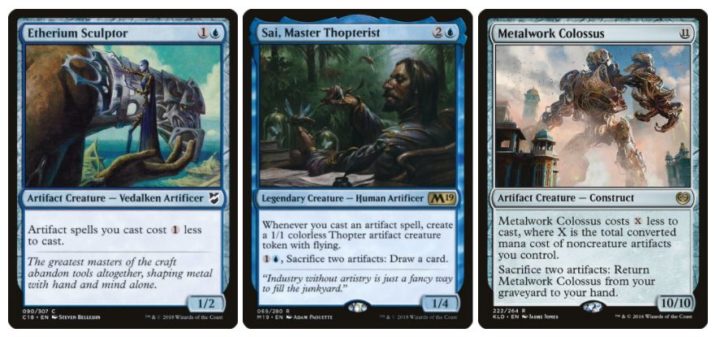
There’s an abundance of synergistic cards that will make this “the artifact deck to keep an eye on” in your pod. Cards like Etherium Sculptor or Foundry Inspector often pull weight orders of magnitude greater than their own, reducing the cost of many of your artifacts to zero. Sai, Master Thopterist rewards you playing more artifacts by giving you more of the same, and threats like Metalwork Colossus are hard to shake off. Traxos, Scourge of Kroog is another cheap beater that’s worth consideration, too.
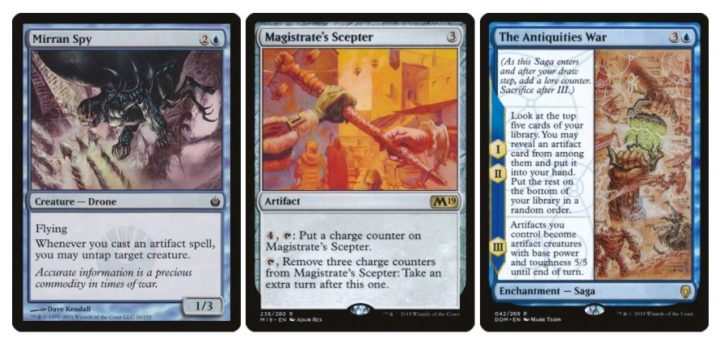
If you somehow haven’t won through attrition with Sai’s thopter army or through hefty Colossus beatdowns, you’ve still got a myriad of options to close the game. The Antiquities War is a “set-and-forget” win condition — you can cast it now and worry about winning with it in a few turns just by surviving with artifacts on board. Magistrate’s Scepter can be used to take several extra turns using Emry and a Coretapper, giving you plenty of time to win. But Mirran Spy is where it gets out of control. If Spy is on board when you bring back the Coretapper using Emry’s ability, they will untap Emry. This means you can replay Coretapper an extra time every turn, resulting in infinite turns. The Spy also works with Emry, a zero-mana artifact like Tormod’s Crypt, and a payoff like Altar of the Brood.
Emry can straddle the line between control and degenerate combo, and turn on a dime to suit the situation you’re in. If you decide to build an Emry deck, you’ll see why she’s the third most popular mono-blue commander on EDHREC.
Naban, Dean of Iteration – Wizard Tribal

Wizards are a well-loved tribe, particularly among Izzet mages. They can be aggressive, disruptive, and fun to play alongside sweet instants and sorceries. One thing that many wizards have in common is that they have excellent enter the battlefield triggers, from drawing cards to bouncing permanents. Naban, Dean of Iteration is a tribal Panharmonicon available at any time from the command zone, turning every wizard from a minor nuisance into a major problem for your opponents.
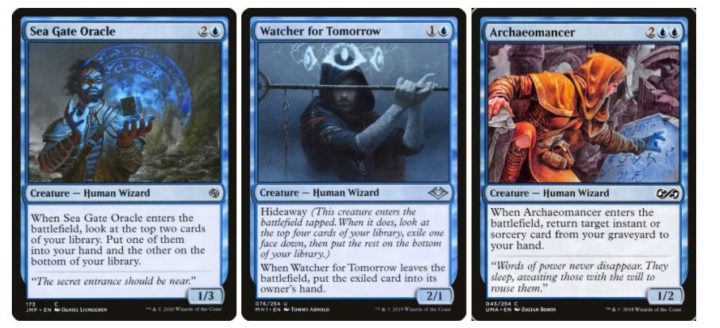
There are countless wizards that replace themselves, either by drawing you a card or pulling something out of your graveyard. Sea Gate Oracle is a classic choice that gives you decent card selection; Watcher for Tomorrow is a newer choice from Modern Horizons, and it doesn’t see enough play despite hideaway being such a powerful ability. You can use Archaeomancer to return a counterspell or some removal, or even use it as a key piece in some loops with flicker effects. All of these become absurd sources of card advantage when Naban is on board.
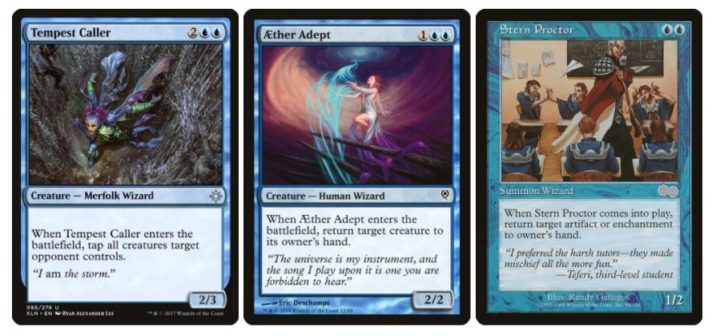
Every deck needs some way to interact with what your opponents are doing, and this deck full of small attackers is no different. Thankfully, those tricksy wizards have you covered. Cards like Aether Adept can remove blockers so you can get aggressive, or you can use them defensively to thin out any opposing frontlines. Tempest Caller is much more aggressive, however, as it’s generally used to make it easy to attack through board stalls. Stern Proctor is another great choice, and it’s very rarely without a few good targets.
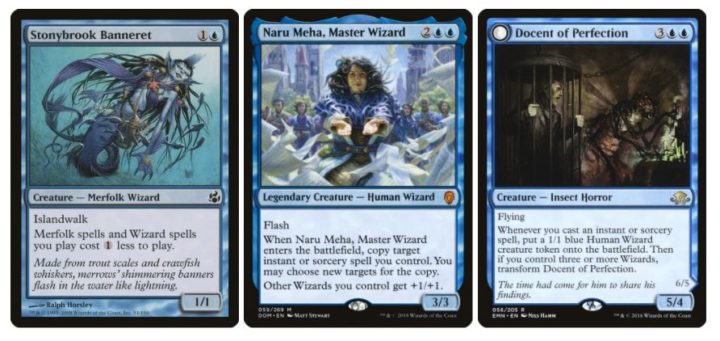
Paying full retail for some of these wizards can be somewhat inefficient given their size, but that’s where Stonybrook Banneret can save you time and mana. With the merfolk on board, your mages will be flooding the table like a crowd at a Black Friday sale. Naru Meha, Master Wizard will seal the deal with her lord effect, and can add a touch of chaos with her enter the battlefield trigger, too. Finally, Docent of Perfection can either help you to recover from a board wipe with just a few small spells, or transform to dispel the stereotype that there’s no such thing as a buff nerd.
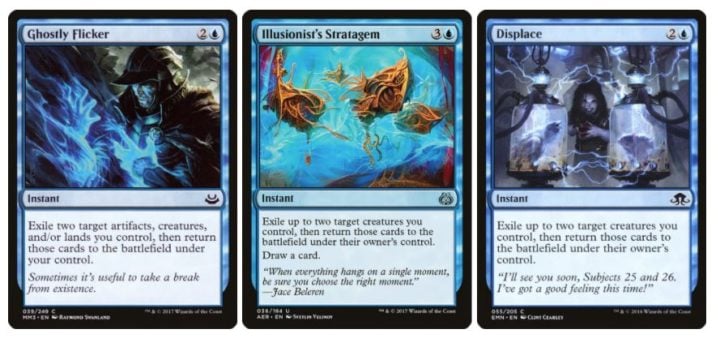
I would be remiss to exclude flicker effects from this wizarding arsenal, as they can lead to some truly absurd turns. As most of your mages have enter the battlefield effects, these will cause them to trigger again — twice if Naban is present! These three spells are some of the best you’ll find for the deck, but they have a few small differences. Displace is the most restrictive, as it only flickers creatures; Illusionist’s Stratagem is the same, but it also draws you a card in the process.
Ghostly Flicker is the gold standard: not only can it flicker creatures, but it can target artifacts and lands, too, opening up unique options for different situations. It can also go infinite with Naru Meha: if you flash her in to copy the Ghostly Flicker, and the copy targets Naru Meha and an Island, you can repeat the process to generate infinite mana! Another trick you can use is to target one creature to trigger their effect again, and also target Archaeomancer to recur your flicker effect. You can do this as many times as you want, spending just three mana every time.
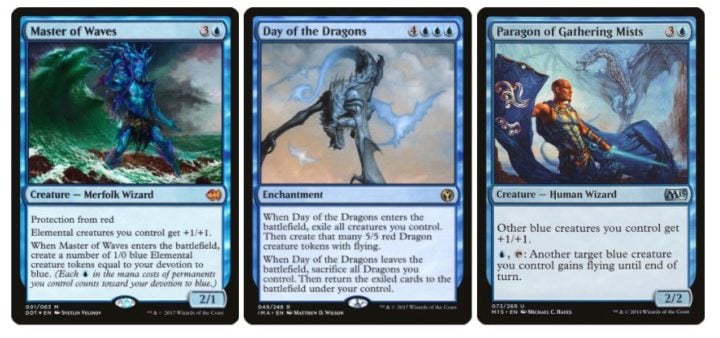
If your team of tricky thinkers can’t get the job done, you can approach the win in a number of other ways. Paragon of Gathering Mists can act as another lord effect, and help your creatures maintain a decent sizing against the field. You can play Master of Waves as a board-in-a-box effect, and as they’re a wizard, they work beautifully with Naban. Day of the Dragons is pricey in terms of casting cost, but does triple duty here: it almost always upgrades the stats of your creatures, it protects your team from a board wipe, and you can bounce it with something like Blink of an Eye to flash your team back in and trigger their abilities at instant speed.
Naban is a fantastic commander that can really hold his own. If you decide to play with him, you’ll enjoy each game so much that you’ll wish you could experience it twice. Plus, everyone loves Panharmonicon! Plus, everyone loves Panharmonicon!
Baral, Chief of Compliance – Counterspells

Blue is notorious for counterspells, and Baral is at the top of the list for greatest offenders. If you love saying “no” to your friends, or you want to make sure that everybody has nice, controlled levels of fun, then this is the deck for you. Many of blue’s best counterspells are at a premium, but Force of Will doesn’t make or break a good deck. So don’t fret, you can still make everyone miserable on a tight budget!

It’s only natural to start with the counterspells. You can play fair with the usual suspects like Negate, but any counter that provides an extra effect is ideal. Rewind effectively costs nothing to cast, and will even net you mana when you have Baral out! Insidious Will is perfect when a counter isn’t the answer to your current problem, or you just want to play around with the stack. If we keep countering everything, we can run out of cards; Dismiss is perfect for this, as it replaces itself while still preventing anything from resolving.
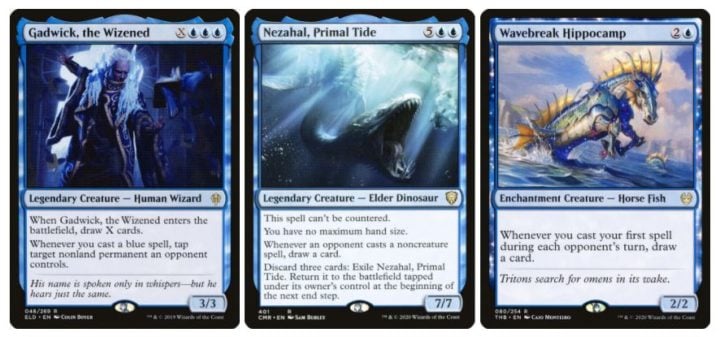
There are plenty of other ways to keep the cards flowing in this deck. Gadwick, the Wizened not only refills your hand in exchange for a mana investment, but their tapping ability can help you keep resolved problems in check. Nezahal, Primal Tide is a great draw engine and a superbly sticky threat — one that’s almost impossible to remove if you set up correctly. Wavebreak Hippocamp essentially draws you a card with almost every counterspell you cast, and when that’s paired with enough cost reducers, it’s almost impossible for your opponents to resolve a thing!
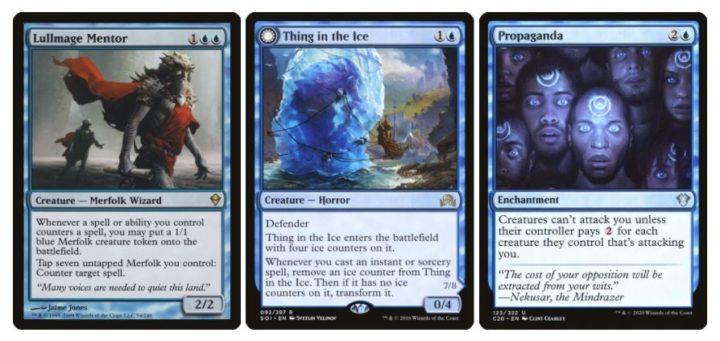
Unfortunately, some spells are going to resolve, so it’s important to be able to play to the board, too. Lullmage Mentor can really churn out tokens in this deck, and eventually, you can even use them to counter spells for you! Thing in the Ice can easily flip in a single turn, bouncing all non-horror creatures and giving you a chance to counter them all over again. If someone does manage to overload your counterspells and start going wide, you can drop Propaganda and deter them from attacking you.
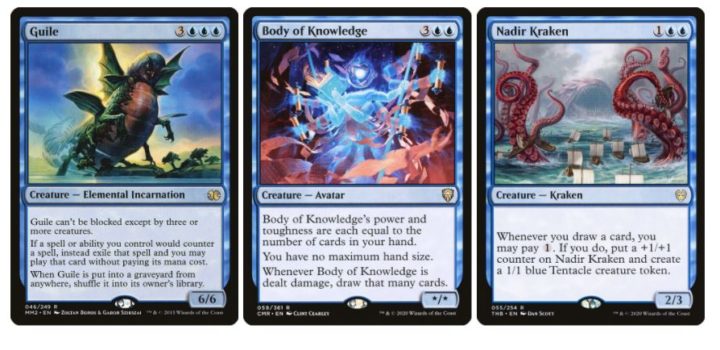
You can hope for your opponents to concede out of frustration, but you need alternatives in case that doesn’t happen. Guile is the quintessential counterspell-heavy win condition, allowing you to steal anything that takes your fancy. Body of Knowledge is a new inclusion from Commander Legends, and once you’re set up, it can prove fatal to opponents in just a few short turns (or agonizingly long ones, from your opponents’ perspective). Finally, Nadir Kraken provides a wonderful low-opportunity win condition; as Baral loots when you counter a spell, you can pay to grow the kraken. In other words, it optionally negates Baral’s cost reduction in exchange for a growing threat, which is an invaluable option at the right time.
If you like the idea of being the bad guy under the guise of a good guy (or vice versa), then there is no better deck to give you that experience. Baral can be a little frustrating to play against at more casual tables, so I wouldn’t recommend it if your playgroup is on a low-sodium diet.
Tetsuko Umezawa, Fugitive – Aggro/Infect

When most people think of aggro, they typically imagine red, white, and occasionally green or black. Blue is usually not associated with aggression, but that’s because we’re usually talking about a lofty forty points of life per player. What if those life totals could be ten instead?
Tetsuko Umezawa is a sweet commander that grants particularly small creatures the ability to be unblocked. This means the small creatures whose effects trigger when they deal combat damage are at their best with this commander.
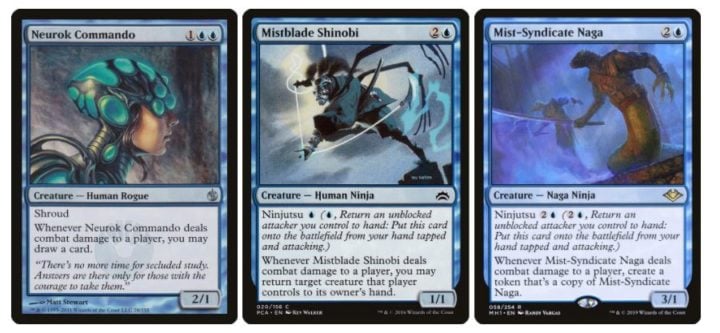
You have an abundance of creatures at your disposal that have powerful, repeatable effects when they connect with your opponents. Neurok Commando will chip away while drawing cards, Mistblade Shinobi is equivalent to an Unsummon every turn, and Mist-Syndicate Naga can get completely out of hand in just a couple turns.
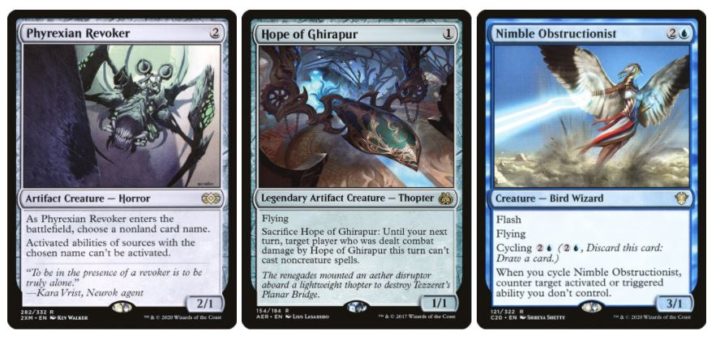
While you can go completely overboard with combat damage effects if you wish, utility creatures are also a wise choice. You can use Phyrexian Revoker to shut down anything from planeswalkers to Nevinyrral’s Disk, and Hope of Ghirapur can Silence a player for a turn in a pinch. Nimble Obstructionist is a personal favorite of mine; you haven’t lived until you’ve countered Ugin, the Spirit Dragon’s ultimate ability with this beautiful bird.
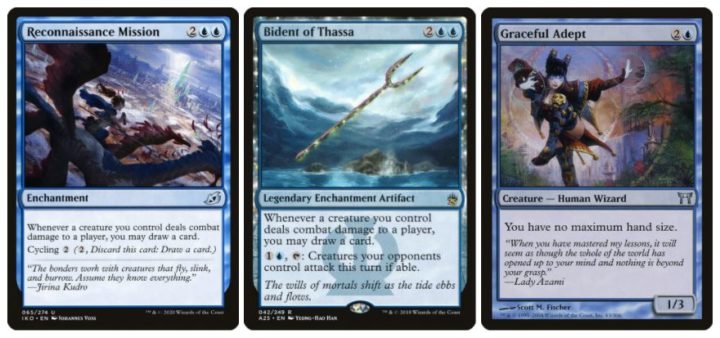
If you’re constantly connecting with your creatures, you might as well reap some rewards! Enchantments like Reconnaissance Mission and Bident of Thassa can completely refill your hand after just one combat step, and the Bident can force an opponent into an awkward attack. Graceful Adept will allow you to take full advantage of the extra cards while also being unblockable with Tetsuko on board.
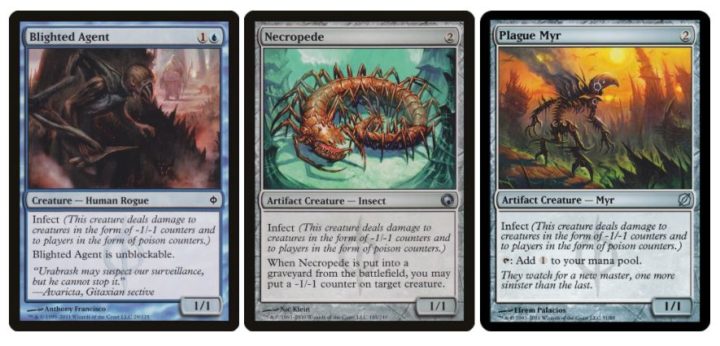
As I mentioned at the start of this section, sometimes forty life per player can be too much even for such a consistent aggressive force. That’s where you can take advantage of the infect mechanic! Most creatures with infect have only one point of either power or toughness, so they can make it through unhindered with your commander. Blighted Agent, Necropede, and Plague Myr all fill this role perfectly. The only problem with these creatures is that they’re not extremely common, so you might only be able to get a single attack in per opponent. That’s where the second part of this plan comes in.
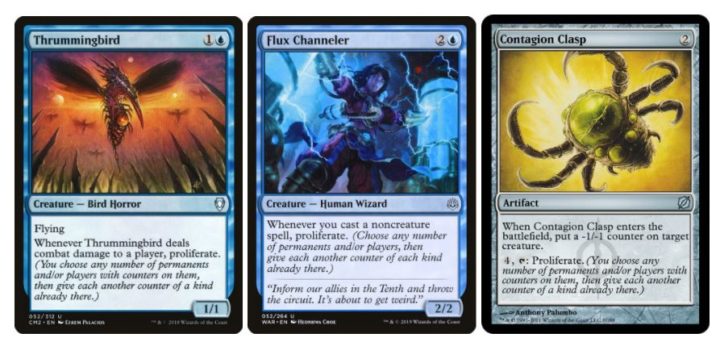
Proliferate is a mechanic that allows you to increase the number of counters on permanents or players, and it happens to work with poison counters. Blue has access to many cheap, repeatable ways to proliferate, and they will often be the way you’ll win longer games. Thrummingbird needs to attack to be effective, but Tetsuko Umezawa removes the dangers involved in doing so. You can proliferate with Flux Channeler multiple times per turn, and it’s only restricted by the number of noncreature spells you can cast. Contagion Clasp is another great option, giving you a small piece of removal with it, too. These may not seem particularly impactful if you haven’t used them before, but once every opponent has at least one poison counter, these all become time-bombs.
Tetsuko Umezawa is a unique, aggressive commander with an exceptional amount of inevitability when you include the infect/proliferate plan. If you want to play an aggro deck with great late game potential — or you simply don’t believe in blocking — then this rogue will be your new best friend.
***
Blue can often get labeled as a color that just draws cards and counters spells. Hopefully I’ve demonstrated the more nuanced aspects of my favorite color, and how affordable they can be.
What do you think of these commanders? What’s your favorite mono-blue deck? Let me know over on Twitter!

Scott is an Irish content creator and the Head of Budget Magic for the Izzet League. He focuses on affordable decks in Pioneer, Modern, and Pauper, particularly ones that stray from the mainstream. When he’s not writing about his favorite decks, he can be found talking incessantly about them on Twitter and on The Budget Magic Cast.

